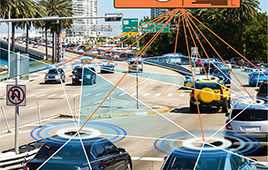 “Imagination is our window into the future,” NASA’s Jet Propulsion Laboratory (JPL) says. The leading U.S. center for the robotic exploration of the solar system, JPL is currently responsible for conducting missions with more than two dozen spacecraft and collaborates with Caltech on projects and missions at five NASA facilities:
“Imagination is our window into the future,” NASA’s Jet Propulsion Laboratory (JPL) says. The leading U.S. center for the robotic exploration of the solar system, JPL is currently responsible for conducting missions with more than two dozen spacecraft and collaborates with Caltech on projects and missions at five NASA facilities:
- Infrared Processing and Analysis Center
- Exoplanet Science Institute
- Spitzer Space Telescope Science Center
- Herschel Science Center
- Galaxy Evolution Explorer Science Center
So, it stands to reason that the lab might occasionally take some time out to envision a day when the creativity of scientists and engineers will allow us to do things that we can only dream of now.
“At NASA/JPL we strive to be bold in advancing the edge of possibility so that, someday, with the help of new generations of innovators and explorers, these visions of the future can become a reality,” the JPL site states. This week, the lab has expanded its exoplanet travel poster series to present virtual trips to a total of 14 alien worlds.
“As you look through these images of imaginative travel destinations, remember that you can be an architect of the future,” the site says.
Last year, the first five posters, which depict planets beyond our solar system, were introduced as part of JPL’s “Exoplanet Travel Bureau” series. They are included in the latest set of 14 posters, which also show such locales as Mars, Jupiter’s moon Europa, Saturn’s vapor-spewing moon Enceladus, and the dwarf planet Ceres. Here are a few of my favorites:
 * Experience the Mighty Auras of Jupiter
* Experience the Mighty Auras of Jupiter
The Jovian cloudscape boasts the most spectacular light show in the solar system, with northern and southern lights to dazzle even the most jaded space traveler. Jupiter’s auroras are hundreds of times more powerful than Earth’s, and they form a glowing ring around each pole that’s bigger than our home planet. Revolving outside this auroral oval are the glowing, electric “footprints” of Jupiter’s three largest moons. NASA’s Juno mission will observe Jupiter’s auroras from above the polar regions, studying them in a way never before possible.
 * Ride the Tides through the Throat of Kraken
* Ride the Tides through the Throat of Kraken
Frigid and alien, yet similar to our own planet billions of years ago, Saturn’s largest moon, Titan, has a thick atmosphere, organic-rich chemistry and a surface shaped by rivers and lakes of liquid ethane and methane. Cold winds sculpt vast regions of hydrocarbon-rich dunes. There may even be cryovolcanoes of cold liquid water. NASA’s Cassini orbiter was designed to peer through Titan’s perpetual haze and unravel the mysteries of this planet-like moon.
 * Queen of the Asteroid Belt
* Queen of the Asteroid Belt
Ceres is the closest dwarf planet to the Sun. It is the largest object in the main asteroid belt between Mars and Jupiter, with an equatorial diameter of about 965 kilometers. After being studied with telescopes for more than two centuries, Ceres became the first dwarf planet to be explored by a spacecraft, when NASA’s Dawn probe arrived in orbit in March 2015. Dawn’s ongoing detailed observations are revealing intriguing insights into the nature of this mysterious world of ice and rock.
The posters are the brainchild of what is known as The Studio at JPL. This design and strategy team works with JPL scientists and engineers to visualize and depict complex science and technology topics. The team’s work is used in designing space missions and in sharing the work of NASA/JPL with the public.
The California Institute of Technology in Pasadena manages JPL for NASA.
- The posters are available free for downloading and printing at: www.jpl.nasa.gov/visions-of-the-future
- More information about JPL is at: www.jpl.nasa.gov




